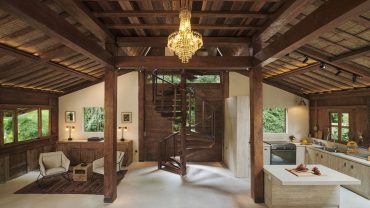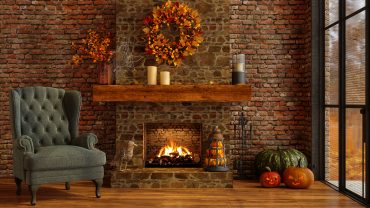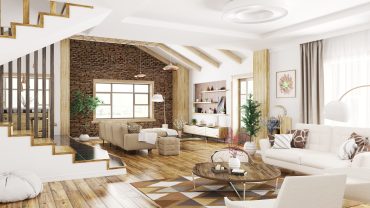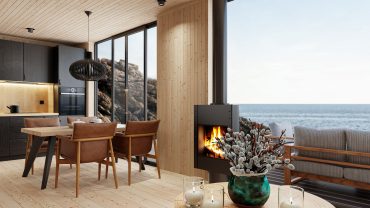The term “gothic” is one heavily laden with connotations. Historically, the Goths played a pivotal role in the fall of the Roman Empire. In fiction, it’s inextricably linked with the horror genre. And then there’s the goth musical subculture with its love of all things dark. And so, it’s no surprise that most would assume gothic interiors to be all black walls, esoteric decor, and low lighting. In fact, Gothic interior design takes its cue from a school of mediaeval architecture; one that thrived in ecclesiastical circles and which revelled in opulence and drama.
In this guide, we delve into the world of gothic interior decor, uncovering its origins, defining characteristics, and how it can be seamlessly integrated into contemporary homes. In other words, we’re answering one question: what is gothic interior design?
A History of Gothic Interior Design

Portrait of Abbot Suger (1081-1151). (Credit: Stefano Bianchetti / Contributor via Getty Images)
Gothic architecture and interior design can be traced back to the churches of 12th century France. It’s often specifically attributed to French nobleman Abbot Suger and his renovation of the Basilica of Saint-Denis in Paris. Back then this architectural style went by different names, sometimes known as Latin or Ogival, meaning pointy, architecture. The term “Gothic” wouldn’t be coined until around the 16th century. In fact, this coincided its decline, with Italian commentators using it as an insult, essentially labelling it barbaric. For instance, designer Giorgio Vasari referred to the style as ‘gothic’ as an allusion to the Germanic people who conquered Rome and destroyed many of its great classical buildings.
Nevertheless, over the course of four centuries, the gothic style thrived across Europe, making the leap from a purely architectural concern to myriad other mediums. It then experienced a revival beginning in the latter half of the 17th century and lasting to the 20th, resulting in numerous iconic creations ranging from the Palace of Westminster and Chhatrapati Shivaji Terminus in Mumbai, to Washington National Cathedral.
So, how does this style translate to a cohesive interior decor? To understand this, let’s look at the features that make up the gothic look.
What is Gothic Interior Design?

The Basilica of St. Denis in Paris, France (Credit: sdstockphoto via Getty Images)
The core principles of Gothic interior design are best understood by reference to the original movement. The gothic aesthetic has its roots in ecclesiastical builds. It emerged from a desire for churches to be larger, taller, and grander. There was an emphasis on natural forms and natural light. And an embrace of opulence and dramatic flair. The results for gothic architecture interior design tended to be vast yawning spaces, heavily ornamental decor, and spires that reached for the heavens. Stained glass was widely used, with enormous windows that would maximise the light.
Some of the gothic features derived from necessity. For instance this increase in size brought with it the need for more supportive structures. And so, on the inside, vaulted ceilings made way for intersecting or “ribbed” vaults, while exteriors saw arches known as flying buttresses extending from their vast walls to the ground to hold them up. Rounded Romanesque arches were eschewed in favour of pointed ones that could be built higher.
Modern Gothic: Adapting Gothic Design for Contemporary Spaces

A bedroom designed in a modern gothic style. (Credit: Vac1 via Getty Images)
Having looked at the original implementation of gothic design, it’s easier than one would expect to incorporate this into a modern interior. While ribbed vaults and sky-high spires might be beyond most homeowners, the themes and principles can be adapted to great effect. Let’s look at how this works in practice.
Colours and Patterns

A typical gothic colour palette.
Dramatic colour is often a great place to start for gothic interiors. Deep purple and red fabrics, gold chandeliers, or ebony walls, if it’s intense, lavish, and luxurious, you’re on the right track. A little goes a long way with such hues, so they can be added in small touches. But the great thing about gothic architecture interior design is that it’s all about excess: more is always more. Patterns can add yet more gothic charm, offering the chance to depict its popular themes, like flowers.
Materials and Textures

Dark wood as seen in this image, is often used for gothic interiors. (Credit: Svitlana Romadina via Getty Images)
Materials and textures play a pivotal role in gothic interiors. Stone, dark wood, and wrought iron are all excellent options, offering robustness and authenticity to the design. Textural contrast is also a key element; the softness of velvet upholstery juxtaposed against the hardness of stone walls creates a dynamic and intriguing space.
Furniture and Accessory Choices

A high-backed, leather Chesterfield chair, commonly used in gothic interiors. (Credit: naphtalina via Getty Images)
In gothic interiors, furniture is characterised by its ornateness and attention to detail. High-backed chairs, elaborate tables, and heavy, carved wardrobes are staples. Accessories like candelabras, tapestries, and religious icons contribute to the Gothic narrative, each piece adding to the overall atmosphere.
Gothic Architecture, Interior Design, and the Modern Home

Bristol Cathedral, which epitomises Gothic architecture (Credit: John and Tina Reid via Getty Images)
And so, gothic interior decor is all about historical elegance and dramatic flair. From the majestic cathedrals of mediaeval Europe to the chic living rooms of today, this style continues to enchant and inspire. For those looking to add a touch of this timeless elegance to their homes, the gothic style offers endless possibilities, blending the mystique of the past with the simplicity of modern design. Whether through a full transformation or subtle touches, gothic interiors can bring a unique and captivating charm to any space.












